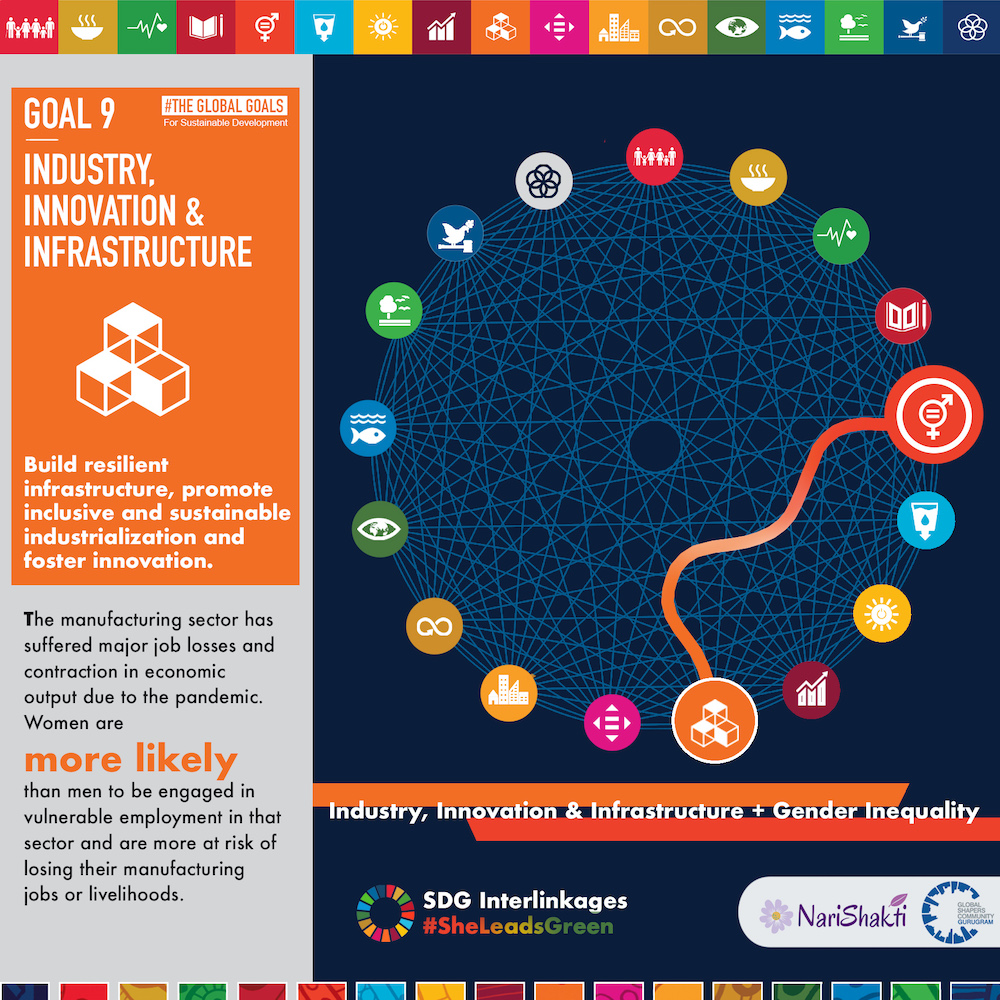
Gender parity for industry, innovation & infrastructure (SDG 9)

Why is it important to look at industry, innovation and infrastructure from a gender lens?
- With SDG 9 on Industry, Innovation and Infrastructure aiming to promote the development of quality, reliable, sustainable and resilient infrastructure, it also aims to promote inclusive and sustainable industrialization and innovations in ICT.
- The goal is cognizant of the fact that in order to transform economies, and make them inclusive and sustainable, the right policies related to infrastructure, industries and innovation need to be instituted.
- It may seem that the process of development and technological innovations is gender neutral, more often that no it is not gender neutral. An example of this can be medical research, which has historically been ignorant of biological sex differences in women’s tolerance and the side effects and benefits from treatments and drugs. This gender blindness in research and innovation and surely result in products and technologies that are harmful to women and girls.
- With respect to industry and trade, while international competitiveness and technological change are heavily subsidized by the low wages of women, it is very much possible that female workers or exploited or displaced as there are technological upgrades in industry occur.
- With respect to jobs in research and innovation, which are driving the transformation towards the ‘knowledge economy’, men continue to dominate. Women comprise 28.8 per cent of the world’s researchers, but large variations are found across regions. In developing countries, there is just one woman per three men; in developed countries, there are two men for every one woman.
How is industry, innovation and infrastructure interlinked with SDG 5?
There are 8 targets and 12 indicators to achieve SDG 9. However, none of the indicators are gender-specific.
With research, innovation, and new industries driving the knowledge economy which forms the backbone of global economic growth, there is a need for gender-sensitive policies and concerted investment in women and girls’ education, and their training is critical. While there are no gender-specific indicators for SDG 9, there is a mention of inclusive and sustainable industrialization in the targets of SDG 9, which point to the need for gender parity as a prerequisite for SDG 9 achievement. With respect to SDG 9, it is critical that the issues and indicators related to
- women’s access to and use of digital financial services,
- women’s satisfaction with road quality,
- women’s internet access,
- and women in STEM positions are explored properly.
How can SDG 9 be achieved with the achievement of gender parity?
- Achieving gender parity will push the agenda of inclusive and sustainable industrialization by 2030, which will significantly raise industry’s share of employment and gross domestic product, in line with national circumstances, and double its share in least developed countries.
- Moreover, there will be extensive support available for domestic technology development, research and innovation in developing countries, which will include a conducive policy environment for, inter alia, industrial diversification and value addition to commodities.
- Through the achievement of the targets of SDG 5, hence achieving gender parity, women will inevitably gain a higher access to the benefits accrued by progress in industry, innovation and infrastructure.
- With gender parity, the target of SDG 9 talking about inclusive and sustainable industrialization within SDG 9 will also see some progress, while the various other targets of SDG 9 will also see progress as women get empowered, given that there will be more diversity of ideas and work done with inclusiveness being the norm.
- With gender parity, it will also be seen that women get higher access to internet access and digital technology, which will decrease the gender digital divide and increase their participation in the economy, which will result in greater economic returns globally due to the higher participation of women.
- In urban poor areas, women are half as likely to be online as men, hence gender parity in these contexts will increase their likelihood of being online, and the resulting benefits will improve the chances of achieving SDG 9.
References:
- https://data.em2030.org/goals/sdg9/
- https://sdg.iisd.org/commentary/policy-briefs/how-can-progress-on-infrastructure-industry-and-innovation-contribute-to-achieving-the-sdgs/
- https://www.unwomen.org/en/news/in-focus/women-and-the-sdgs/sdg-9-industry-innovation-infrastructure
- https://www.unwomen.org/-/media/headquarters/attachments/sections/library/publications/2019/progress-on-the-sdgs-the-gender-snapshot-2019-single-pages-en.pdf?la=en&vs=5813


